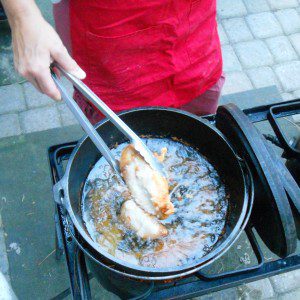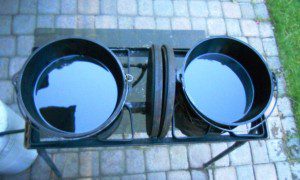by Leon Pantenburg
 |
| Buy survival kits! |
Ronnie Anglin, my neighbor in Mississippi, had a well-stocked pond, and I had a key to the gate. The bream (we called them bluegill, up north) and bass were prolific and in danger of over-populating. I had a standing invitation to remove as many as possible.
At least once a week during the summer, I'd stop by his house, pick up Keith, Ronnie's 11-year-old son, and we'd go fishing. We'd take the catch back to Ronnie's to clean and freeze. Then, about once a month or so, we'd have a fish fry and Bluegrass pickin' party. Talk about great memories!
 |
| Frying fish outside is similar to frying chicken. |
In many parts of the country, a fish fry is the conclusion of a successful day of angling. With fried fish as the main course, side dishes are generally made of whatever summer vegetables might be in season.
In Central Oregon, where I live, there are several species of prolific fish that are in no danger of overharvest. Always check the regulations, but in some lakes or rivers, there are no catch limits on crappie, large-mouth bass and bluegill.
In other areas, such as Central Oregon's John Day River, catfish have been stocked to provide sport- fishing opportunities and good eating. In these instances, wild fish can be eaten without guilt, and there is no better method of enjoying your catch and feeding a lot of people than with a fish fry.
Here’s how you put on a fish fry:
Lean fish works best for frying. The general rule of thumb is that white-fleshed fish is lean, while dark or pink flesh is oily. Good candidates for a fish fry include bass, crappie, catfish, walleye or bluegill. Large, oily fish, such as salmon or trout, aren’t the best choice for frying, because the end result will tend to be greasy and soggy.
It’s possible to deep-fry whole, cleaned fish, but then you must deal with the bones when dining. The best approach is to fillet the larger fish. Once the fillet is cleaned and skinned, cut it into pieces about 1 to 2 inches wide, and no thicker than 1½ inches.
Dip the fillet into a mixture of milk and egg, then dredge it in a flour or cornmeal mixture. If you’re using a batter, all that has to be done is dip the fillet.
Off grid cooking methods, used outside, work best for cooking for a crowd. I use a pair of 12 or 14-inch cast-iron Dutch ovens on my twin burner Camp Chef propane stove for frying. This takes the heat, the smell and any oil spattering outside.
The trick to deep-frying fish is to have very hot oil: 375 to 400 degrees. This is the point where vegetable oil bubbles if a small amount of batter is dropped in. Use a candy thermometer to ensure the correct temperature. Vegetable oils for deep-frying must have a high burning point. Corn, canola, peanut, cottonseed or safflower are popular because they don’t change the flavor of the fish.
Usually, when fish turns out greasy, it is because the oil cooled down too quickly. Start with about 400 degrees, then when the cool fish hits the hot oil, the breading will form a tasty golden crust. The fish will cool the oil when it goes into the fryer, so keep an eye on your thermometer to maintain a steady heat.
Test a piece when the batch is done. Underdone fish is transparent and watery, and doesn’t flake easily with a fork; overdone fish is dry and hard when tested. Just-right fish is opaque and moist and flakes easily. You’ll reach this just-right state by cooking the fish for 3 to 5 minutes or until it floats and is golden brown. Don’t crowd the fish, or the oil will cool too much.
If cooking several batches of fish, let the oil reheat to at least 375 degrees before adding fish.
 |
| Ready to cook fish for a large group |
If the fish and batter are cold, and the oil is hot, the coating will seal immediately. The cooked fish will be moist and flaky inside, crisp and brown in the outside. Drain cooked fish on a cookie sheet lined with a paper bag.
Serve the fish hot, right out of the oil, with side dishes. Then sit back, enjoy, and be thankful for the good food and fellowship that can come from time spent outdoors.
In the South, hush puppies, a type of fried corn bread, and coleslaw are virtually mandatory at a fish fry. Here are some recipes to help you get started:
Beer Batter
1 C all-purpose flour
3 TBS cornstarch
1 tsp salt
1/2 tsp paprika
Dash nutmeg
1 C beer
1 TBS vegetable oil
In a medium bowl, mix dry ingredients. Blend in beer and vegetable oil until smooth. Dip fish into batter and deep-fry.
Basic Flour Breading
1 egg
1 TBS milk or water
1 C all-purpose flour
1 tsp salt
1/2 tsp pepper
Blend egg and milk. Mix flour, salt and pepper. Dip fish in egg mixture, then in flour mixture. Deep fry.
Corn Meal Breading
1 egg
1 TBS milk or water
1 C fine ground cornmeal
3 TBS Italian-flavor bread crumbs
1 TBS flour
Salt, pepper, paprika, Old Bay seasoning or Cajun seasoning to taste
Blend egg and milk. Mix corn- meal, bread crumbs, flour and seasonings. Dip fish in egg mixture, then in flour mixture. Deep fry.
George’s Hush Puppies
Hush puppies are the traditional southern side dish to accompany fried fish. (This recipe was concocted by my friend, the late George Halford, one night before a fish fry in the Washington, D.C., area.)
2 C cornmeal
2 TBS all-purpose flour
2 eggs
1/4 C canola oil in batter
1/4 C honey
5 green onions, finely chopped
1 C buttermilk
4 tsp baking powder
Dash of garlic salt
In a large bowl, combine cornmeal, flour, egg, cornmeal, garlic salt, honey, green onions and buttermilk, stir thoroughly with spoon. Stir in baking powder. Heat oil to 400 degrees in large Dutch oven. Drop batter by spoonfuls into hot oil, and fry until golden brown on both sides. Drain on paper towels.
Fried Sweet Corn
6 ears fresh, white sweet corn (yellow sweet corn can be used, but it won’t be as tasty)
1 TBS butter
Salt and pepper to taste
Husk and clean the corn. Using a very sharp knife, cut the tips of corn into a baking pan. Then, use the back of the knife to scrape and milk the cob, letting the juices run into the pan. Pour the corn into a large bowl, and add salt and pepper to taste. Heat a skillet over medium heat and drop in butter. When butter is melted, put the corn and juices in skillet. Cook on medium heat for about 20 minutes until the corn is smooth, creamy and hot.
No comments:
Post a Comment